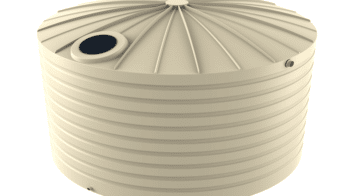
Proper maintenance of your inground water tank, along with the catchment system, roof gutters and inlets are essential, especially during a dry season – a long hot summer – and before any heavy rain is expected. Roof catchments and gutters should be inspected, cleared of leaves and other debris, try and make this a regular changing season routine. If there are any over-hanging branches, remove them as well. Cleaning your gutters regularly is great for both collecting rainwater and fire prevention. Don’t forget Eucalyptus trees will continue dropping their leaves throughout summer and especially after a hot spell. If you want to, you can install gutter mesh or guard; there are also some pretty cool self-cleaning gutter systems available too.
Check your downpipes and drainage to the tank, make sure it is all clear and clean if you need to give it a flush out once a year. It’s also helpful to install drain points and a first flush diverter to maximise the run-off quality when it does rain.
Look at and clean out the entry box, the downpipes dump into a leaf basket which needs to be checked and cleaned regularly. This can end up as a contamination point as all the water entering the tank, passes through this.

All screens should be cleaned regularly, water tanks, both above ground and best quality inground water tanks should never be allowed to become breeding sites for mosquitoes. If you do have mosquitos breeding find the entry point and ensure it’s closed. For most types of tanks, mosquitos breeding can be stopped with the addition of a teaspoon of domestic kerosene, this will eventually evaporate. NEVER use power kerosene as it will taint the water.
Desludging – every 2-3 years all tanks should be examined for the accumulation of sludge. If there is any present, it should be removed by syphoning the tank or by completely emptying the tank – desludging. Do It Yourself cleaning of the tank presents some risks – including working in confined spaces. Tanks that have a cone scour base are easy to clean, just open the cleaning outlet to allow the water to gush out with the sludge and then rinse with a hose. Small, flat-bottomed tanks can be drained, rinsed with a hose and then tilted to drain.
One method for cleaning a flat-bottomed tank is to get inside with a bucket, shovel and broom and dig out the sludge. A second person should be present to ensure the safety of the person inside. Clean a big tank early in the morning or when the area is shaded – this is to prevent heat exhaustion. If you need light inside the tank, use a battery lantern DO NOT use a flame or a light with an electric extension.
If you are using chemicals for a repair inside the tank, you may need a respirator. Alternatively, in some areas, there are professional tank cleaners who can do the job for you.
A concrete tank could crack if it dries out, so check with your supplier if the type of tank you have can remain empty for a few weeks, you may find you have to put water in the tank to stop it from cracking. Plastic tanks will need to have some water inside them – or be strapped down, to prevent them from being blown over in strong winds when they are empty.
By doing some small tasks each year and making sure your downpipes are set up properly, you stand a good chance of sludge not building up. The easiest way is to regularly check your tank.
Pay attention to:
- The level of water, so you don’t run out of water at short notice
- Make sure there are no insects swimming or flying around, and while it might be a novelty – it’s not good to have frogs swimming around, especially if this is your drinking water.
- The leaf basket, roof liner and hatches are all working, if anything needs to be repaired or cleaned – sort it out
- Alive insects and animals aren’t too bad – dead ones are dangerous!
Once you have given your tank the once-over, carry out a little maintenance – you should try and do this every 6-8 weeks. You don’t know when it will rain again, and when it does, you don’t want lots of rubbish and dirty water going into your tank.
Read More :





